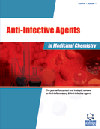- Home
- A-Z Publications
- Anti-Infective Agents in Medicinal Chemistry (Formerly Current Medicinal Chemistry - Anti-Infective Agents)
- Previous Issues
- Volume 7, Issue 3, 2008
Anti-Infective Agents in Medicinal Chemistry (Formerly Current Medicinal Chemistry - Anti-Infective Agents) - Volume 7, Issue 3, 2008
Volume 7, Issue 3, 2008
-
-
Anti-inflammatory Properties of Lactic Acid Bacteria: Current Knowledge,Applications and Prospects
More LessLactic acid bacteria (LAB) represent a heterogeneous group of microorganisms that are naturally present in many foods. Some selected strains are frequently added as probiotics in order to confer specific benefits to consumers. Many studies have shown that LAB possess therapeutic properties since they are able to prevent the development of some diseases, as shown mostly on animal models for cancer, infections and gastroin Read More
-
-
-
Antimicrobial Host Defence Peptides of Human Neutrophils - Roles in Innate Immunity
More LessAuthors: A. Bjorstad, K. L. Brown, H. Forsman, C. Dahlgren, A. Karlsson and J. BylundThe innate immune system is an old defence mechanism that in primitive organisms consists mainly of humoral components like antimicrobial peptides. Many of these peptides share features such as size, cationicity, amphipathicity and kill microbes primarily by lysing the cell membrane. In more evolved organisms, humoral factors are supplemented by cellular components such as professional phagocytes, but the antimicro Read More
-
-
-
Targeting Bacterial Metalloenzymes: A New Strategy for the Development of Anti-Infective Agents
More LessMetalloenzymes are widespread proteins, ubiquitous in all life kingdoms, being involved in various biosynthetic processes. Some of them have been extensively studied in mammals and there are excellent examples for mechanism- based inhibitor design. α-Carbonic anhydrases (CAs), matrix metalloproteinases (MMP), or angiotensin-converting enzyme (ACE), among others, are clinically exploited targets in the treatment or pr Read More
-
-
-
Peptidoglycan Glycosyltransferase Inhibition: New Perspectives for An Old Target
More LessPeptidoglycan cell wall is an essential polymer for growth and development of most bacteria. The glycosyltransferase domain of bifunctional class A penicillin-binding proteins and monofunctional GTs proteins catalyze the polymerization of uncross linked glycan chains of the peptidoglycan whereas the penicillin-binding transpeptidases catalyze the cross-linking between peptides of neighboring glycan strands. The biosynthe Read More
-
-
-
Multivalent Presentation Strategies in Novel Inhibitors of Bacterial (Toxin) Adhesion and Synthetic Vaccines
More LessAuthors: Roland J. Pieters and Rob M.J. LiskampMulti-arm constructs were synthesized and used in three different contexts, all involving pathogenic bacteria. Glycodendrimers containing either the GM1os ligand or its greatly simplified relative galactose, were found to be very strong cholera toxin inhibitors, especially at higher valencies. Related glycodendrimers containing the galabiose epitope were strong inhibitors of the adhesion of the bacterial pathogen Streptococcu Read More
-
-
-
HIV-1 Infection: Recent Developments in Treatment and Current Management Strategies
More LessTwenty-four years after the identification of HIV-1 as causative agent of the acquired immunodeficiency syndrome (AIDS) the pandemic continues to call for novel drugs and for new management strategies. Several steps in the HIV-1 replication cycle are potential targets for treatment interventions. Twenty-five compounds are approved by the FDA but there is still urgent need for new classes of antiretroviral drugs. Majo Read More
-
-
-
Design and Synthesis of Imidazole and Benzimidazole Derivatives as Antifungal Agents
More LessAuthors: S. Khabnadideh, Z. Rezaei, A. Khalafi-Nezhad, K. Pakshir, A. Roosta and Z. BaratzadehTwo different series of N-substituted heteroaromatic compounds related to clotrimazole structure were synthesized. In one series ortho-cholortrityl moiety of clotrimazole was replaced by trityl, mono or dimethoxy trityl (series c). In the second series the imidazole ring of clotrimazole was also replaced by benzimidazole (series d). Chemical structures of all the new compounds were confirmed by spectrophotometric methods. T Read More
-
Most Read This Month
Article
content/journals/aiamc
Journal
10
5
false
en


